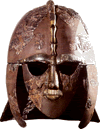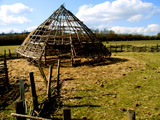Treasures of Saxon Archeaology
Sutton Hoo
 The excavation of a burial mound in Suffolk in 1939 first brought up some of the most impressive treasures ever found in England. The remains of a ship of about 30 metres in length contained a helmet, shield and many Anglo-Saxon gold ornaments, Byzantine silver weapons and many other artefacts. The treausre was removed for the duration of World War II. Excavation of the site continued from 1965, with various investigations carried out.
The excavation of a burial mound in Suffolk in 1939 first brought up some of the most impressive treasures ever found in England. The remains of a ship of about 30 metres in length contained a helmet, shield and many Anglo-Saxon gold ornaments, Byzantine silver weapons and many other artefacts. The treausre was removed for the duration of World War II. Excavation of the site continued from 1965, with various investigations carried out.
The most famous find is the helmet. pictured here. The helmet has elements that recall both Roman war helmets and those excavated in the royal mounds in Uppsala in Sweden.
The Sutton Hoo finds show the mix of design elements and metal-working skills that were available at the time of the Anglo-Saxons. They show the high levels of craft skills that the rich could access at the time often known as the "Dark Ages." The constant social upheavals of this period, when the territory of Great Britain was apparently being disputed by most of the tribes in Northern Europe, also seems to have brought exposure to artefacts from a wide variety of European sources. indigenous .
The National Trust maintains the Sutton Hoo site and provides a range of facilities. There is information for visitors on the National Trust website. There are more details about the mounds and the contents of the burial on wikipedia http://en.wikipedia.org/wiki/Sutton_Hoo
 In addition to the traditional archeaological work that has taken place, there are also numerous examples of people rebuilding houses and even villages in the style of the late Iron age / Saxon period. An example of this is the round house which was constructed at Cholderton Rare Breeds Farm in Hampshire (pictured), although there are numerous similar projects around the country.
In addition to the traditional archeaological work that has taken place, there are also numerous examples of people rebuilding houses and even villages in the style of the late Iron age / Saxon period. An example of this is the round house which was constructed at Cholderton Rare Breeds Farm in Hampshire (pictured), although there are numerous similar projects around the country.